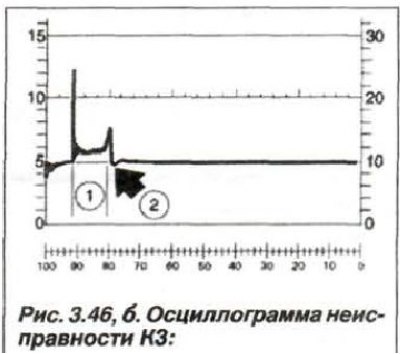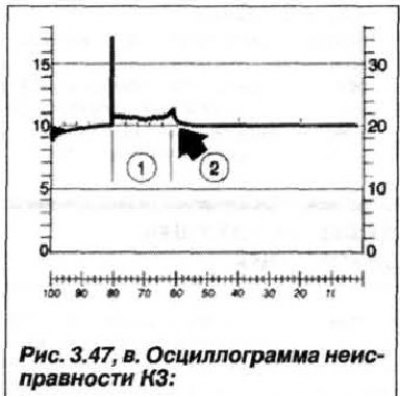
- 1 - the beginning of the damping process at normal upper and lower oscillation amplitudes;
- 2 - a strong reduction in the amplitude of oscillations of the beginning of the attenuation process (top arrow), the ignition coil is faulty;
- 3 - the lower amplitude of the beginning of the oscillation damping process is absent (bottom arrow), the coil is bad.
Note. Increased amplitude (3) fluctuations in the maximum value of the breakdown voltage are not always observed.
Analysis of the voltage curve at the electrodes of the spark plug at idle:
- ignition coil good (pic. 3.46,a).

1 - normal duration of the spark discharge; 2 - normal attenuation of oscillations after the spark discharge voltage is applied to the spark plug electrodes
- ignition coil defective (pic. 3.46.6).

1 - reduced duration of the spark discharge; 2 - weak attenuation (arrow) fluctuations after applying spark voltage
- ignition coil defective (pic. 3.46, in).

1 - greatly reduced duration of the spark discharge; 2 - attenuation (arrow) oscillations after applying the voltage of the spark discharge is absent
- ignition coil defective (pic. 3.46. G). There are no voltage fluctuations at the spark plug electrodes.

Analysis of the voltage curve at the electrodes of the spark plug for the speed of the crankshaft at partial loads (1500 min-1):
- ignition coil good (pic. 3.47,a).

1 - normal duration of the spark discharge; 2 - normal attenuation of oscillations after the spark discharge voltage is applied to the spark plug electrodes
- ignition coil defective (pic. 3.47.6).

1 - reduced duration of the spark discharge; 2 - weak attenuation (arrow) fluctuations after applying spark voltage
- ignition coil defective (pic. 3.47, in).

1 - normal duration of the spark discharge; 2 - attenuation (arrow) oscillations after applying the voltage of the spark discharge is absent
